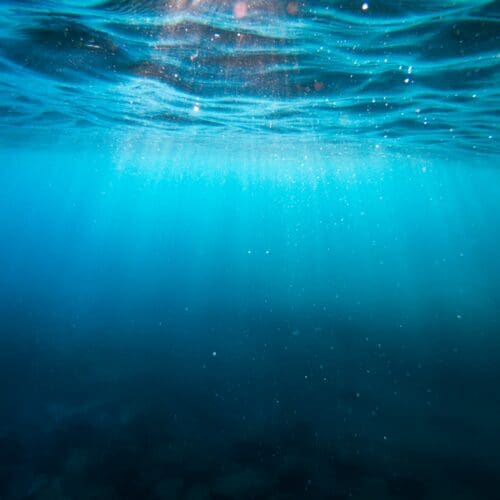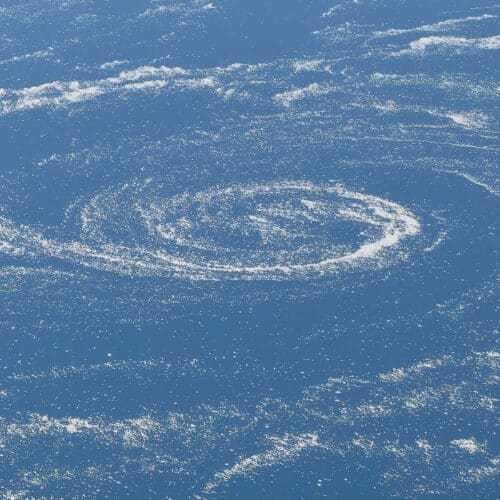Marine Carbon Dioxide Removal
Harnessing the Power of the Ocean to Restore the Climate and the Ocean
The ocean and climate are inextricably interconnected; the state of one drives the state of the other. Making up 71% of the planet’s surface, the ocean influences weather and climate by absorbing solar radiation, distributing that heat and associated moisture throughout the ocean, into the atmosphere, and around the globe, and driving global weather systems.
However, after 10,000 years of relative stability in this ocean-climate dynamic, the effects of the last 170 years of accumulated greenhouse gas emissions now threaten the stability of the entire system. Elevated greenhouse gases trap an enormous amount of extra heat from the sun, 90 percent of which has gone into the ocean, wreaking havoc on numerous functions and systems in the ocean—including the loss of oxygen. Additionally, roughly 30 percent of all the excess CO₂ has been absorbed into the upper layer of the ocean, causing it to become more acidic. Efforts to restore the health of the ocean cannot ultimately succeed without resolving the overlying driver of harm; far too much CO₂ and other greenhouse gas pollution in our air and water.
Cleaning Up Greenhouse Gas Pollution - the Overlooked Part of the Climate Solution
Currently, most efforts to address the climate crisis remain focused on reducing emissions of greenhouse gas pollutants. While vital, this path alone is no longer sufficient.
The Intergovernmental Panel on Climate Change has made clear that large-scale carbon dioxide removal (CDR), of between 100 and 1000 gigatons, will be needed this century to have a chance to hold temperatures to a 1.5°C increase—the goal set out in the Paris Agreement. If we would like a safer and more stable climate, even more removal would be needed.
The hopeful news is that there are many potentially promising ways to clean up this massive amount of CO₂ pollution.
Carbon dioxide removal can take many forms, from land management practices such as forest restoration, to technologies like direct air capture. To date, most CDR development has been focused on land-based solutions.
Less known is another set of approaches to carbon removal with particularly strong potential – those that depend on the power and size of the ocean.
The Ocean as a Part of the Climate Solution: Ocean-Based Carbon Dioxide Removal (CDR)
Types of Ocean-Based Carbon Dioxide Removal Approaches
- View Ocean-Based CDR Overviews & Illustrations:
Road Maps to Accelerate the Testing and Development of Ocean-Based Carbon Dioxide Removal
Given the pace and scale of the climate disruption now fully underway, and the very real danger of surpassing critical ecological tipping points in the ocean, it is imperative to accelerate the research and testing of various ocean-based CDR approaches.
To chart the way forward, Ocean Visions collaborated with experts from around the globe to develop a series of road maps that lay out key priorities to advance our collective knowledge of ocean-based CDR technology pathways. The road maps are focused on electrochemical CDR, microalgae cultivation and carbon sequestration, blue carbon restoration and carbon sequestration, macroalgae cultivation and carbon sequestration, and ocean alkalinity enhancement. An additional two maps were developed on critical cross-cutting issues related to the enabling environment for ocean-based CDR research and development: building and maintaining public support, and expanding finance and investment.
The road maps were designed to focus global attention and catalyze engagement on the most critical areas of work needed to advance our knowledge. The maps will be updated and refined regularly as progress is made, new priorities identified, and advances emerge in science, technology, governance, and policy.
A Comprehensive Program to Prove or Disprove Marine Carbon Dioxide Removal Technologies by 2023
There has been a great deal of debate about the potential contributions of marine carbon removal techniques to help blunt the ocean-climate crisis, but the reality is these discussions are occurring in an environment of very limited field data. To get actionable information, we must rapidly advance a comprehensive RD&D effort designed to answer the fundamental questions around additionality, durability, safety, costs, and social acceptability of each approach. Released in 2023, Ocean Visions’ high-level road map outlines a comprehensive program to do just that, centered around three interconnected pillars of needed work: Science, Technology, and Policy.
Supporting and Evaluating Developing Technologies
A diverse global community is beginning to advance needed research and development of marine-based CDR. Ocean Visions is catalyzing action across a number of fronts in this space, connecting scientists, managers, environmentalists, investors, business people, policymakers, and others to drive research and testing of different approaches and technologies:
- Ocean Visions’ Launchpad program is providing expert support to ocean-based innovators.
- Ocean Visions’ ocean-based CDR Community brings together practitioners and stakeholders to advance the state of knowledge, build bridges across disciplines, and help the community move towards safe and equitable testing and piloting of the most promising approaches.
- An mCDR Field Trial Database allows the community to explore known field trials worldwide and contribute insights.
Ocean Visions believes that by harnessing human ingenuity across a multisector and multidisciplinary community, we can create solutions to the most pressing challenges at the ocean-climate nexus. Learn more about our approach.
Core Principles Guiding Ocean Visions' Work on Carbon Dioxide Removal and the Ocean
Our work is predicated on, and guided by, these core principles.
Ocean-Based CDR Factsheet
Download our factsheet on ocean-based CDR.







